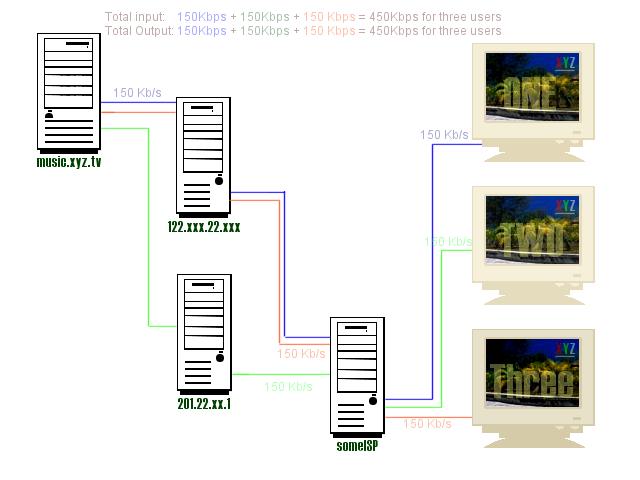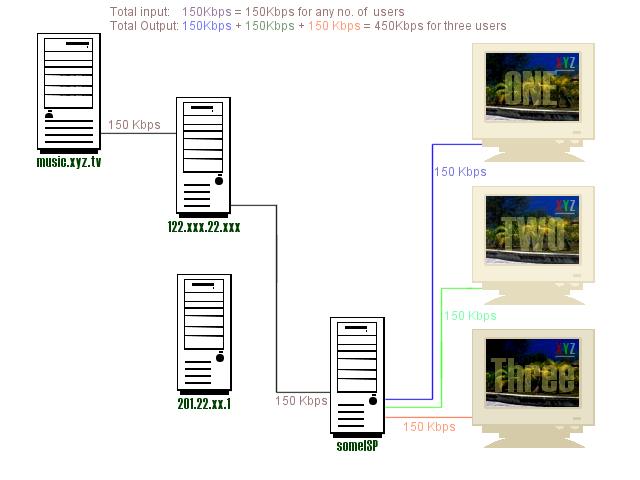The material in the following documents is written and developed by Vivek
Jishtu. Any work derived from SAVTP requires my written consent so before you continue
reading this document make sure you agree to this term. This is a conceptual protocol if
you think that you or your company can develop the protocol then please contact me at.
vivekjishtu@yahoo.com or mailme@vivekjishtu.com
Introduction to SAVTP
SAVTP means Streaming Audio Video Transfer Protocol. It is a conceptual protocol that can reduce redundancy of data due to which people can see live digital television all across the globe at any given point of time. The best part of this protocol is that it can work as of now and will also be able to work in the future. This protocol works on the principal of packet sharing. This protocol can help in the convergence of TV and the Internet.
How does SAVTP work?
Before discussing how SAVTP can transmit data, lets see how data (streaming audio and video) moves across the net today. Lets say that at a certain ISP(someISP) three people are connected to a site named (music.xyz.tv). Then three separate connections* have to be set up to connect to the site as even now multicasting is not really possible across the internet.

Lets say user ONE connects to the server at music.xyz.tv, the data comes to him from the main server (music.xyz.tv)which then goes to 122.xxx.22.xxx (any fictions IP) and finally reaches him through his ISP server (someISP). Lets say after sometime user TWO and THREE also join in to watch the program being streamed by (music.xyz.tv) then two more connections have to be setup. That means for every new user a separate connection has to be setup. To top it all, the total amount of bandwidth wasted in transmitting the redundant data is huge. Lets say that the video file that was being streamed was at a bitrate of 150 Kb/s, to stream three consecutive videos to the same place would mean that 450 Kb/s of redundant data is being sent,by using SAVTP this redundancy can be reduced. This protocol is not a replacement for multicast as many people after reading the previous paragraph might have thought. This protocol can also make use of the multicasting. This protocol basically helps us in reducing the redundancy of data across a network.
Lets me explain the concept in detail. Here I will be using the same example as above that of the three users who are connected to music.xyz.tv who are watching a video being streamed at 150Kb/s, but here a new hardware would have to be installed at the ISP which would basically be a computer which would store the incoming data for a certain amount of time (not more than a second), in this document I would call this as an AVS (Audio/Video Server). This computer would act something like a proxy server. The AVS would act both as a client as well as a server. Before I go into the details of this server lets see how data would flow across the network using SAVTP.

Lets say user ONE wishes to connect to music.xyz.tv using a SAVTP client. The client application requests the AVS at the ISP to send the streaming video from music.xyz.tv , the AVS searches its database whether the stream is available, as user ONE is the first user to ask for the video stream the AVS connects to music.xyz.tv server, this way the AVS at the ISP subscribes to a video stream from music.xyz.tv , now lets say that user TWO also wants to watch the video being streamed, so user TWO’ s SAVTP client requests the AVS to send the video stream. Now the AVS checks its database for the video stream, and as the video stream is found the stream is sent to him from the AVS instead of going to music.xyz.tv . The same thing happens when more users get connected to watch the video. The AVS subscribes to the video stream till no user wants to watch that particular channel.
Lets look at what a sample chat between an AVS and a SAVTP client would look like. Here I am just showing you a very basic type of interaction between the client and the server , the actual way of interacting with each other would differ a lot in the actual case
C1 : - User ONE
C2 : - User TWO
C3 : - User THREE
AVS : - Audio Video Server at the ISP (someISP)
SAVTP : - The main SAVTP server (music.xyz.tv)
| C1: | The SAVTP client application asks the AVS to send a video stream from music.xyz.tv |
| AVS: | The AVS would look for the video stream in its database, but , as the video stream is not available as yet it connects to music.xyz.tv and subscribes to the video stream |
| AVS: | The AVS which is acting like a client subscribes to the video stream from music.xyz.tv |
| SAVTP: | SAVTP sends the video stream to the AVS |
| AVS: | AVS stores 150 KB of data in its RAM (Because the bitrate of the video is 150Kb/s) |
| AVS: | AVS now acts as the server and sends the data it got from the SAVTP server to C1 which had asked for the video stream. |
| C2: | Requests AVS to send the video stream from music.xyz.tv |
| AVS: | The AVS looks for the video stream in its database and as it finds it, because C1 had asked for it, the AVS sends the video stream to C2 |
As more people join in the amount of bandwidth saved is enormous. Lets take a case when 30 people on the ISP (someISP) are watching the same program.
150Kb
x 30 = 4500Kb (This much bandwidth is required)
4500Kb – 150Kb =
4350Kb (This much is saved by using SAVTP)
Even if you've just understood 10% of what is written in here then contact me, and I will try to make the concept more clearer. Contact me now at vivekjishtu@yahoo.com
If you or your company think that you would like to make this protocol then contact me, as soon as possible and I will send you the following
- Using SAVTP for I-TV (interactive television)
- Technical details of SAVTP
- A document on making a SAVTP server
- A document on making an AVS server
- A document on making a SAVTP client
- Subscriptions/Encoding channels
- Packet sharing
- Other ways by which you can benefit from SAVTP
- Linking two or more AVS (Audio Video Servers) together
Get in touch with me now @
vivekjishtu@yahoo.com or
mailme@vivekjishtu.com